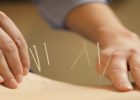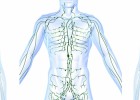1. Acupuncture: An extraordinary therapeutic method over two millennia old
Acupuncture treats diseases by the insertion of fine needles into the body. In July of 1971, Dr. Henry A. Kissinger made a secret trip to China to prepare for President Nixon’s historical visit. Among his entourage was James Reston, a journalist from the New York Times. While in China, Reston suffered an attack of acute appendicitis and underwent an appendectomy at the Beijing Union Medical College, established by the Rockefeller Foundation of New York in 1916. During the second night after the operation, Reston started to experience considerable discomfort in his abdomen.
With his approval, an acupuncturist at the hospital inserted and manipulated three long thin needles, one into the outer part of his right elbow and one below each knee. There was noticeable relaxation of the abdominal pressure and distension within an hour, with no recurrence of the problem thereafter. James Reston included a detailed description of his experiences with acupuncture in his dispatches from Beijing. This was the first such report to reach the English-speaking citizens of the United States, at least the vast majority who had no daily contact with Asians.
By contrast, acupuncture has been known and practiced in China for over 2300 years. Qin Yueren, the earliest recorded Chinese practitioner, is considered to be the founder of acupuncture. A biography of Qin Yueren is included in the Records of the Grand Historian (Shi Ji), the masterwork of the eminent Chinese historian Sima Qian (135 – ? BC). It is known that Qin Yueren lived around 407-310 BC, and was a contemporary of Hippocrates (c. 460-377 BC), the father of Western medicine.
Qin Yueren traveled widely throughout the feudal states that compromised China during his time, treating men and women, old and young alike. As a result, he was given the auspicious appellation Bian Que, which means Wayfaring Magpie – a bird that flies here and there dispensing good fortune. Several carved stones, unearthed from a tomb dating back to the Eastern Han Dynasty (25-220 AD), portray him with a human head and a bird’s body.
On one occasion, while passing through the State of Guo (present-day Shan County in Henan Province), Bian Que learned that the Prince of Guo had died and his subjects were preparing to inter him. After careful examination, Bian Que believed that the prince had merely experienced a type of deep coma known as deathlike reversal. He successfully resuscitated the patient by needling an acupoint on the vertex of his head, and become known for bringing the dead back to life. This was the first recorded use of acupuncture in China.
Acupuncture is extraordinary. Needles have historically been among the most common tools of daily life, used for constructing garments all over the world. Just as needles are used to sew clothes, they are also utilized medically to suture incisions. While hollow syringes are used to inject fluids into the body or to draw them out, pricking the body with a solid acupuncture needle to treat illness seems quite incomprehensible. Most people prefer not to be punctured with needles, and associate needling with pain and injury. No wonder, to “needle” a person means to displease or to irritate in English. By trial and error, healers throughout the world have independently discovered similar treatments for pain and disease, including herbs, roots, wraps, rubs, blood-letting, massage, meditation, or surgery. But the invention of acupuncture is unique to China.
Why did the ancient Chinese begin to treat disease by puncturing the body with bare needles? A generally accepted answer to this question is that acupuncture evolved as a natural outgrowth of daily life in the Neolithic Age (c. 8000-3500 BC), through a process of fortuitous accident and repeated empirical experience. According to this theory, people noticed cases in which physical problems were relieved following an unrelated injury. This led to the discovery of the principle that injury to a certain part of the body can alleviate or even cure a pre-existing disease or disorder in a different part of the body.
It is thought that with this discovery, Neolithic Chinese people eventually started to use stones, animal bones, or pieces of bamboo to deliberately induce injury to relieve physical problems. The traumatic nature of acupuncture, which seems quite crude by modern standards, as well as its long history in China, seem to lend credence to the theory of its prehistoric origins. However, if acupuncture did indeed arise from repeated empirical experience of accidental injury, it should have developed all over the world, rather than solely in China.
2. Meridians of the Body: The rivers of the Earth in microcosm
According to traditional Chinese medicine, a network known as “meridians” is distributed throughout the human body, carrying Qi (vital energy) and blood to nourish the organs and tissues. Meridians of the human body are very similar to rivers of the earth in both structure and function. Rivers are the meridians of the Earth in macrocosm. They are the channels that contain the flow of water, the life force of our planet. On the microcosmic scale, the meridians of the human body are the channels that contain the flow of Qi and blood, the life force of living beings.
The ancient Chinese found that there are twelve Regular Meridians in the human body. The Neijing or Huangdi Nejing (the Yellow Emperor’s Inner Classic of Medicine) (compiled between 104-32 BC) is the seminal work of traditional Chinese medicine and the earliest extant medical exposition of acupuncture. The chapter entitled “Regular Watercourses (Jingshui)” deals specifically with the correspondences between the twelve Regular Meridians and the twelve major rivers in China. The rivers mentioned are located in the basins of the Changjiang River and the Yellow River.
The techniques and terminology of flood control offer a vivid analogy of the therapeutic mechanisms of acupuncture. Blockages in these “energy rivers” act as dams, obstructing the flow of Qi and blood and causing it to back up in connecting channels. Needling the acupoints removes the obstructions, curing disease by reestablishing the regular flow of Qi and blood. In the same way, dredging a river by clearing away sediment prevents flooding by allowing the water to flow freely. Similar descriptions of flood control and acupuncture have been used since acupuncture first appeared as a comprehensive system of healing early in China’s Western Han Dynasty (206 BC-24 AD). Such hydraulic terminology has been employed not simply for its evocative imagery. Rather, it indicates the understanding the Chinese ancestors have attained by this time of the correspondences between Nature and Human, river and meridian, flood and disease.
3. Dredging rather than Diking: The unparalleled mastery of flood control attained by the Chinese ancestors
China is located on an immense and steep continental slope, unlike any other in the world. The Qinghai-Tibet Plateau, located in the western part of China, is the highest and geologically youngest plateau on Earth. It is known as the Roof of the World, with an average elevation of 4000-4500 meters. A Chinese saying states, “The higher the mountain towers, the higher the water rises.” The vast and cloud-kissed Qinghai-Tibet Plateau is the largest and highest natural water tower on Earth, storing snow precipitated from water vapor emitted by the world’s oceans and seas. As the compacted snow melts away under the sun, drop by drop, the liberated water flows naturally downward to the east and accumulates into tiny streams, which then converge into mighty torrents that empty back into the ocean.
China’s two longest rivers, the Yangtze River and the Yellow River, originate in the heights of the Qinghai-Tibet Plateau. They have been essential to agricultural development and population growth throughout China’s history. But due to the tremendous drop in altitude from the Qinghai-Tibet Plateau to sea level, water in these rivers flows extremely rapidly and may easily cause flooding. The Yellow River, the world’s muddiest river, is especially infamous for its destructive floods.
The Yellow River’s name refers to the vast quantities of yellow silt, or loess soil, it carries. Loess formations are extremely vulnerable to erosion by water. As the Yellow River winds through the Loess Plateau in northwestern China, the raging torrent picks up yellow silt in unusually large amounts and sweeps it downstream. As the river reaches flatter areas the current slows, depositing massive amounts of yellow silt and elevating the riverbed.
Attracted by the fertile lands of the Yellow River’s middle and lower reaches, the prehistoric ancestors of the Chinese people settled down along its banks to create a culture based on planting, fishing and hunting. However, these trailblazers were soon threatened by the river’s severe and protracted flooding. During the early stages, they may have resided on natural or artificial uplands or led nomadic lives to avoid flooding, while also imploring supernatural forces for help. But as their population increased, they had no other choice but to strive to harness the river’s enormous power.
This defining aspect of Chinese culture is reflected in one of China’s oldest and most popular legends, the story of how Great Yu controlled the flood. It is said that during the Wudi or Five Emperors Period (c. 2700 to 2000 BC), severe flooding spread over the country and brought great disaster to the people. Emperor Yao appointed his minister Gun to harness the river and control the waters. However, Gun’s attempts to obstruct the flood by erecting dikes and dams failed. Gun’s son Yu was appointed by the next emperor, Shun (c. 2100 BC), to continue his father’s work. Drawing a lesson from his father’s failure, Yu noticed and took advantage of the downward flowing nature of water. He dredged canals according to the physical features of the terrain, to lead the water finally to the sea. After thirteen years of hard work, the floods subsided.
It may be difficult to separate fact from legend in the case of Great Yu, but China’s long history of flood control is indisputable. The most valuable principle the ancient Chinese learned from their work with flood control was that dredging or diverting water to flow naturally downward is superior to diking or other attempts to obstruct the water’s passage.
The Dujiang Canal (Dujiang Yan), the most famous water conservancy project of ancient China and the entire ancient world, is a prime example of the use of dredging and water diversion for flood control. Completed in 256 BC, approximately contemporaneous with the appearance of acupuncture, the Dujiang Canal represents the peak of ancient Chinese hydraulic engineering. It has continued to play an important role in flood control, irrigation, and shipping up to the present day. The oldest operational water conservancy project in the world, the Dujiang Canal was added to UNESCO’s list of World Heritage sites in 2000.
The long history and unique mastery of flood control attained by the Chinese ancestors, exemplified by the Dujiang Canal, was a direct outgrowth of the geographical conditions they faced. Destructive floods are depicted in the myths and legends of many ancient nations, for instance, the story of Noah and the Flood in the Bible. However, there are no legends concerning flood control. This is a direct result of the physical environment of these ancient peoples.
Egypt has depended on the Nile River in both ancient times and modern times. Like a silver strip, the Nile flows across the Saharan desert, creating a corridor of life. Water is invaluable in the desert, creating oases wherever it appears. For the Egyptians, the yearly flooding of the Nile is a blessing rather than a disaster, irrigating and fertilizing the farmland of the Nile River Valley. This yearly flood is so vital to survival that the ancient Egyptians viewed it as the annual renewal of the first act of creation. If the waters did not rise high enough to innundate the surrounding farmland with water and fertile alluvial soil, drought and famine would result.
The ancient Egyptians therefore never developed flood control methods, and in fact prayed for the flood if it did not occur on time. Believing that the Nile god Hapi controlled the floods, they celebrated the yearly “Arrival of Hapi” and worshipped him with offerings, hoping that the Nile would rise up enough to provide both water and silt for the farmland.
The two rivers, the Yellow River and the Nile River, bring different gifts to their residents. While the flooding of the Nile River fertilizes farmland in Egypt directly, “China’s Sorrow” inspired ancient people to create a unique healing method.
4. Clearing the Meridians with Needles: Using the laws of the Nature to cure the ills of the human body
A fundamental concept of Chinese philosophy is the “Unity of Humanity and Heaven.” It implies that Humanity, Society, and Nature form an integrated system, and that each part is similarly constituted and governed by the same laws. Laozi (c. 6th century BC), the founder of Daoism, states: “Humanity is modeled upon Earth, Earth is modeled upon Heaven, Heaven is modeled upon the Dao, and the Dao is Nature itself.”
This holistic model of thinking was widely applied in the field of medicine. The early Chinese physicians were philosophers as well. They believed that the processes of the human body may be understood by observing and analyzing the phenomena of the universe, and that the disorders of Humanity can be managed using the principles of Nature. Therefore they held that medical practitioners should not only study the human body, but also should “know Heaven above and Earth below.”
The ancient Chinese philosopher-physicians realized that since the rivers and meridians are similar in structure, the flow of water in the rivers and the flow of Qi and blood in the meridians adhere to the same rules, and that their disorders can therefore be similarly managed. If a river course becomes silted up, the water in the river, which by nature flows downward, will overflow and result in flooding. If a meridian is obstructed, the Qi and blood it carries, which by nature flow in a circulatory path, will become stagnant and various disorders may occur. The healers of the human body therefore cleared the meridians by puncturing with needles to promote the flow of Qi and blood and cure disease, just as the healers of the Earth dredged the river courses using picks and shovels to direct the waters and control the flood.
The twelve Regular Meridians are distributed throughout the body, forming a network that links the upper and lower, and the internal and external, into an organic whole. The Qi and blood flow through the meridians to nourish the entire body. Furthermore, specific sites, called Caves of Qi (qixue) or acupoints, are located on the skin along the pathways of the meridians. These sites are often located in small depressions, usually between the muscles, tendons, bones, or in bony holes. When one is ill, the flow of Qi and blood slows, tending to stagnate at the indented sites which lead to obstruction of the meridians. Insertion of fine needles into these points can effectively promote the flow of Qi and blood and remove obstructions, promoting recovery.
Clearing the meridians of the human body with needling to allow the free circulation of the body’s energy is a direct application of the central principle of effective flood control – encouraging the desired flow by clearing channels rather than by erecting barriers.
The authors of the Neijing express the correspondence between flood control and acupuncture in this way: “Those versed in the laws of Nature excavate a pond at its lowest point, so that the water within the pond can be drained off and strenuous labor avoided. According to the same logic, they dredge the meridians at the acupoints, the cave-like depressions where Qi and blood deposits. In this way, the meridians can be freed with ease.”
5. Acupuncture: A true symbol of traditional Chinese culture
Rivers originate from mountains and empty into the seas. The erosion of soil at the upper reaches is the principal cause of flooding, so the most effective means of flood control is to conserve water and soil at the upper reaches. The meridians originate at the ends of limbs and end at the abdomen, chest, and head. Therefore, when using acupuncture to treat disease, headache is not treated by needling the head, but rather by needling the feet. Acupuncture, in its use of the laws of Nature to cure the ills of the human body, offers a visible expression of the concepts of Chinese holistic philosophy. The practice of needling the lower part of the body to cure the upper, and treating the outer to heal the inner is nothing less than holism made visible.
Acupuncture developed into its full form no later than the 2nd century BC, around the same time that the Chinese ancestors perfected their principles of flood control in the great Dujiang Canal water conservancy project. Just as water always flows downward, the theory and practice of acupuncture have never undergone fundamental change. Since its inception, satisfactory results have been achieved by puncturing the same sites with the same instruments.
An acupuncture needle may seem unromantic, but it represents the essence of traditional Chinese culture. Acupuncture is not merely a healing art, but a vivid symbol of thousands of years of Chinese culture.
Acupuncture is unique, original and representative. Not only does acupuncture exemplify the height of traditional Chinese culture, but its continued use over thousands of years confirms the value of the Chinese holistic principles that it embodies. The stability and vitality of acupuncture demonstrate why Chinese civilization has endured for over five thousands years.
6. Acupuncture: Over 1500 years of globalization
The worldwide dissemination of acupuncture can be divided into four stages. Acupuncture has spread to at least 140 countries and areas to date.
First Stage: By around the 6th century AD, acupuncture had begun to spread to the neighboring lands of Korea, Vietnam, and Japan. Particularly in Japan, the fundamental texts of acupuncture were imported, absorbed, and studied with great care.
541 AD: Chinese practitioners are dispatched to Korea by the Chinese government.
552 AD: The emperor of China presents Japan a copy of the Classic of Acupuncture (a section of the Yellow Emperor’s Classic of Internal Medicine (Huangdi Neijing).
562 AD: Monk Zhi Cong brings the Manual of Channels and Acupoints (Mingtang Tu) and the Systematic Classic of Acupuncture and Moxibustion (Zhenjiu Jiayijing) to Korea and Japan.
754 AD: Jian Zhen, a high official of the Tang Dynasty (618-907 AD), crosses the sea to Japan to promulgate Buddhism and Chinese medicine.
Second Stage: By around the 12th century AD, acupuncture had started to reach the Middle East via the Silk Road.
Third Stage: By the late 1500’s to early 1600’s, acupuncture had begun to filter into Europe by way of Japan and the Maritime Silk Road, transmitted by the Jesuits in particular.
1671 AD: Harvieu, a Jesuit monk, produces the first French translation of a work on acupuncture when he returns to France from Macao and Beijing.
1683 AD: Willem Ten Rhyne, a Dutch physician who visited Nagasaki in Japan in the early part of the 17th century, publishes Dissertatio de Arthride: Mantissa Schematica de Acupunctura, a Latin dissertation on acupuncture, in London and invents the European term “acupuncture.”
1810 AD: The first recorded use of acupuncture in Europe occurs at the Paris School of Medicine when Dr. Berlioz employs it to treat a young woman suffering from abdominal pain. The Paris Medical Society describes this as a somewhat reckless form of treatment.
1823 AD: Acupuncture is mentioned in the first edition of the Lancet.
Fourth Stage: Since the early 1970s, acupuncture has spread dramatically throughout the world, catalyzed by Nixon’s historic visit to China and popularized by the World Health Organization (WHO).
1971: James Reston reports on his experience with acupuncture in Beijing in the New York Times. This article represents the first news of acupuncture to reach the English-speaking citizens of the United States, or at least the vast majority who have no daily contact with Asians.
1973: The American Journal of Acupuncture starts publication, playing an important role in the clinical practice and study of acupuncture in the West.
1976: Dr. Bruce Pomeranz, a professor in the Department of Zoology at the University of Toronto, publishes an original article stating that analgesia in acupuncture is mediated by endorphins. His research is the first to utilize the Western scientific paradigm to explain why acupuncture works.
1979: An international conference on acupuncture, moxibustion, and acupuncture anesthesia sponsored by WHO is held in Beijing and attended by participants from twelve countries. Its purpose is to discuss ways in which priorities and standards for acupuncture may be determined in the areas of clinical practice, research, training, and transfer of technology. The conference draws up a provisional list of diseases that lend themselves to treatment with acupuncture.
1987: The World Federation of Acupuncture Societies (WFAS) is founded in Beijing. Today, the WFAS has 76 branches representing over 70,000 members from 43 countries and regions.
1997: The National Institute of Health (NIH) of the United States acknowledges the effectiveness of acupuncture in the treatment of a number of diseases.
1998: The Journal of the American Medical Association (JAMA) launches a column devoted to alternative and complementary therapies.
2000: The British Medical Association (BMA) delivers a report on acupuncture and concludes that acupuncture is safe and effective for treating a number of diseases and disorders.




